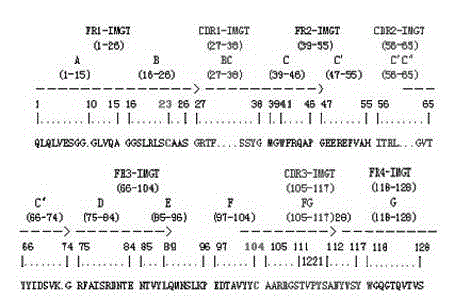Nano antibody-based deoxynivalenol mimic antigen and application thereof
A technology of deoxynivalenol and nanobody, which is applied in the biological field, can solve the problems of restricting the application and promotion of immunological detection methods, threats to the health of detection personnel and the environment, and high price, and achieves good effects, cost saving, Harm reduction effect
- Summary
- Abstract
- Description
- Claims
- Application Information
AI Technical Summary
Problems solved by technology
Method used
Image
Examples
Embodiment 1
[0025] Example 1. Construction of camel-derived natural single domain heavy chain antibody library
[0026] 1) Separation of camel-derived leukocytes: add lymphocyte separation solution to the centrifuge tube, then add blood samples, centrifuge at 700g for 20min; carefully draw the leukocytes suspended in the middle layer into a new centrifuge tube, add 1 / 2 volume of PBS, Centrifuge at 800g for 15min; discard the supernatant, wash the leukocytes on the wall of the centrifuge tube with PBS, and centrifuge at 850g for 10min; discard the supernatant, resuspend the leukocytes in 300μL PBS and count them; add lysate (RNAiso) at a volume ratio of 1:10 and save for later use.
[0027]2) Extraction of total RNA: Add 1 / 5 volume of chloroform to the above lysate, shake vigorously for 15 s to fully emulsify, let stand at room temperature for 5 min; centrifuge at 12000g at 4°C for 15 min, take the supernatant and transfer to another fresh centrifuge into the tube; add an equal volume of i...
Embodiment 2
[0049] Example 2. Affinity panning and identification of DON mimic antigen
[0050] 1) Affinity panning of DON mimic antigen: First, dilute anti-DON monoclonal antibody with PBS (pH 7.4), coat the microtiter plate with a final concentration of 10 μg / mL, and incubate at 37 °C for 4 hours. The next day, after washing 3 times with PBST (10mM PBS, 0.5% Tween-20 (v / v) ), 300 μL of 7% BSA-PBS (3% OVA-PBS) was added to block for 2 hours at 37°C. After 2 hours, the blocking solution was discarded, washed 5 times with PBST, and 100 μL camel-derived natural single domain heavy chain antibody library (titer about 2.0×10 11 cfu), incubate at 37°C for 1 hour. Aspirate unbound phage, wash with PBST 10 times, add 100 μL of Glycine-HCl (0.2M, pH 2.2) to elute for 6-8min, and immediately neutralize with 15 μL of Tris-HCl (1M, pH 9.1). Take 10 μL of the eluted phage to determine the titer, and the rest is used to infect 20 mL of E. coli The TG1 strain was amplified. On the third day, the...
Embodiment 3
[0054] Example 3. Sequencing of DON mimetic antigen-encoding gene and determination of its amino acid sequence
[0055] The phage clones displaying the DON mimic antigen identified by indirect competition ELISA were subjected to DNA sequencing, and the amino acid sequence of the DON mimic antigen could be obtained according to the DNA sequencing results and the codon table. The amino acid of the simulated antigen of the present invention is obtained, and the sequence is as SEQ ID NO.:1.
PUM
 Login to View More
Login to View More Abstract
Description
Claims
Application Information
 Login to View More
Login to View More - R&D
- Intellectual Property
- Life Sciences
- Materials
- Tech Scout
- Unparalleled Data Quality
- Higher Quality Content
- 60% Fewer Hallucinations
Browse by: Latest US Patents, China's latest patents, Technical Efficacy Thesaurus, Application Domain, Technology Topic, Popular Technical Reports.
© 2025 PatSnap. All rights reserved.Legal|Privacy policy|Modern Slavery Act Transparency Statement|Sitemap|About US| Contact US: help@patsnap.com


